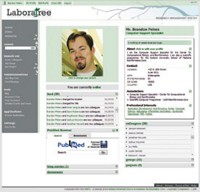Advertisement
Grab your lab coat. Let's get started
Welcome!
Welcome!
Create an account below to get 6 C&EN articles per month, receive newsletters and more - all free.
It seems this is your first time logging in online. Please enter the following information to continue.
As an ACS member you automatically get access to this site. All we need is few more details to create your reading experience.
Not you? Sign in with a different account.
Not you? Sign in with a different account.
ERROR 1
ERROR 1
ERROR 2
ERROR 2
ERROR 2
ERROR 2
ERROR 2
Password and Confirm password must match.
If you have an ACS member number, please enter it here so we can link this account to your membership. (optional)
ERROR 2
ACS values your privacy. By submitting your information, you are gaining access to C&EN and subscribing to our weekly newsletter. We use the information you provide to make your reading experience better, and we will never sell your data to third party members.
Environment
Digital Briefs
New software and websites for the chemical enterprise
August 7, 2006
| A version of this story appeared in
Volume 84, Issue 32
Software
Quick Access software increases the productivity of mass spectrometry users by directing operator workflows and optimizing usage of multiple systems from a single computer. The software is designed for use in high-throughput laboratories where routine mass spectrometry analyses are performed by nonspecialists. Quick Access allows high-throughput labs to simplify and optimize the workflow for casual operators. A single user can set up methods and monitor analyses for dozens of users. Through an easy-to-use computer interface, the software directs operators to submit their samples to the appropriate system with the shortest queue. Varian, www.varianinc.com
ACD/IntelliXtract is an LC/MS software package for automated molecular weight determination, component extraction, sample comparison, and LC/MS data interpretation. The software considers ion adducts, multimers, 12C/13C ratios, isotopes, neutral losses, and fragment ions, providing accurate and quick molecular ion identification. ACD/IntelliXtract combines existing ultrasensitive peak extraction and noise reduction technology with a unique self-optimizing algorithm for automatic component identification and spectrum interpretation. The software can be used to complement manual interpretation of data, for automated data analysis in high-throughput laboratories, and for sample comparison. Advanced Chemistry Development, www.acdlabs.com
SuperStar is a program for generating maps of interaction hot spots in protein binding sites or around small molecules using crystallographic information about intermolecular interactions. The program retrieves data from IsoStar, a database from the Cambridge Crystallographic Data Centre containing information about nonbonded interaction from both the Cambridge Structural Database and the Protein Data Bank. SuperStar features quick generation of maps, the ability to predict metal coordination sites, built-in cavity detection that automatically selects appropriate residues, and Gaussian functions. The software is supported on UNIX (including Linux) operating systems. Cambridge Crystallographic Data Centre, www.ccdc.cam.ac.uk
Galahad is a ligand-based design application that allows the generation of rapid, high-quality pharmacophoric perception and molecular alignments. The software enables the user to automatically develop pharmacophore hypotheses and structural alignments from a set of molecules that bind at a common site and is ideal for exploring new targets and new modes of action. The application, developed on real-world data sets, uses a new genetic algorithm that defines each molecule as a core structure plus a set of torsions. Tripos, www.tripos.com
Databases
BindingDB is a public, Web-accessible database of binding affinity data for biomolecules, genetically or chemically modified biomolecules, and druglike compounds and proteins that are drug targets. The database now holds nearly 18,000 measurements, and data sets can be viewed at the site or downloaded for off-line use. The database currently contains data generated by isothermal titration calorimetry and enzyme inhibition methods; other techniques will be included in the future. The website also provides unique tools for virtual screening of the user's compound database to look for actives against a given protein target. BindingDB is funded by NIH and is designed for use by chemists engaged in drug discovery and by molecular biologists. Center for Advanced Research in Biotechnology, www.bindingdb.org
Analytical Sciences Digital Library is a collection of Web-based resources related to chemical measurements and instrumentation. ASDLib content includes links to more than 325 sites containing animations, online texts, PowerPoint lecture slides, tutorials, simulations, and virtual experiments. The materials in the collection are peer reviewed and annotated to provide short descriptions of the site content and the level of student for which the site is most appropriate. The site also contains a feature, Online Articles, which are peer-reviewed articles published by ASDLib, with the author retaining copyright. The online article format allows publication formats that are not supported by traditional print journals. Areas covered by this site include e-Courseware, e-Labware, e-Educational practices, and e-Undergraduate research highlights. ASDLib is funded by a National Science Foundation initiative. Analytical Sciences Digital Library, www.asdlib.org
Online
Electrochemical Science & Technology Information Resource is a site that contains general information about electrochemistry, including journals, books, reviews, meetings, nomenclature, and handbooks. Hosted by the Ernest B. Yeager Center for Electrochemical Sciences at Case Western Reserve University, Cleveland, the website contains more than 1,000 links to other related online resources and includes more than 500 websites of professors carrying out electrochemical research in more than 60 countries. The site also lists more than 2,500 books and proceedings volumes and more than 4,000 review chapters. electrochem.cwru.edu/estir
Digital Briefs is written by Stephen Trzaska, who can be reached at s_trzaska@acs.org.






Join the conversation
Contact the reporter
Submit a Letter to the Editor for publication
Engage with us on Twitter